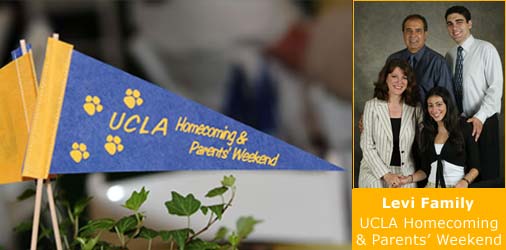“Parents’ Weekend at UCLA” revealed many of the intimate details of Jewish life on campus. One of these details was the extent to which our leadership takes note of our involvement and progress within the greater UCLA community.

On Friday evening, moms and dads accompanied their Bruin progeny to Shabbat dinner at the UCLA Hillel on Hilgard Avenue. The event attracted over two-hundred students, parents, and guests. After the Sabbath was ritually welcomed and the meal was served, those present were treated to a sermon given by Hillel’s Executive Director, Rabbi Chaim Seidler-Feller. Seidler-Feller, who has held the position for nearly forty years, voiced his observation that Jewish students today are far less competitive in their respective academic fields than those who attended university three or four decades ago.
Rabbi Seidler-Feller referenced changes in student demographics, ultimately suggesting that Jewish students today face less marginalization in the university setting than did our collegiate predecessors. The quota system of accepting pre-set percentages of various ethnicities into Ivy-League universities has been largely phased out. Five of the eight Ivy-League schools boast Jewish populations that comprise 25% of the greater undergraduate population. At UCLA, 10.1% of the approximately 27,000 undergraduate students are Jewish.
Additionally, Seidler-Feller pointed out that a number of professors who have ascended to the highest echelons of academia and other fields are deeply-connected Jews. Leonard Kleinrock, a key developer of the internet, holds a professorship in computer science at the UCLA School of Engineering. Judea Pearl, a reputable computer science professor at UCLA, also directs the Daniel Pearl Foundation and compiled the 2004 book “I Am Jewish.” Even UCLA’s chancellor, Gene Block, attends High Holiday services at Hillel. But the age of Jewish academic heroes may be in its decline.
While the success of Jews in science, technology, law, and the liberal arts can be easily identified, our continued success in the future is far less of a certainty. Rabbi Seidler-Feller posited that the previous two generations of Jewish students witnessed the Holocaust, immigrated to the United States, or were first-generation Americans. Their desire to rise within the ranks of American society inspired a persistent influx of of Jews into universities, many of whom eventually achieved leadership positions and essentially shaped academia and any other fields to which they applied themselves.
Are Jewish students today less inspired than their ambitious parents or grandparents? Perhaps. But Rabbi Seidler-Feller identified another factor that he believes lies at the root of the phenomenon. Jewish youth today are decidedly less interested in maintaining their Judaism than the past two generations had been. The enormous opportunity for Jewish students to integrate into the university community as Americans, rather than Jews, has afforded them the opportunity of pursuing all avenues of life on campus. Academic excellence is no longer all we’ve got. The inquisitiveness that Judaism encourages is slowly being forgotten by a generation of students whose Jewish involvement is approaching non-existence. Seidler-Feller concluded with a reflection that other minority groups are witnessing the boom of academic success. It seems that as the story of Jewish success in America has progressed beyond the university, others are filing in to fill the niche that got us to where we are today.

